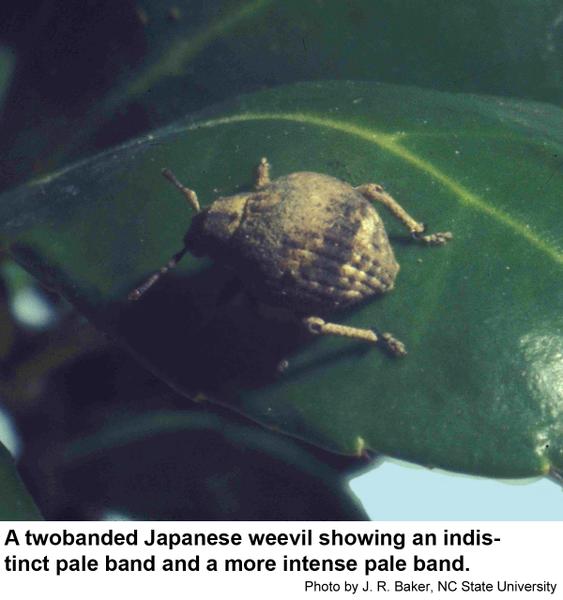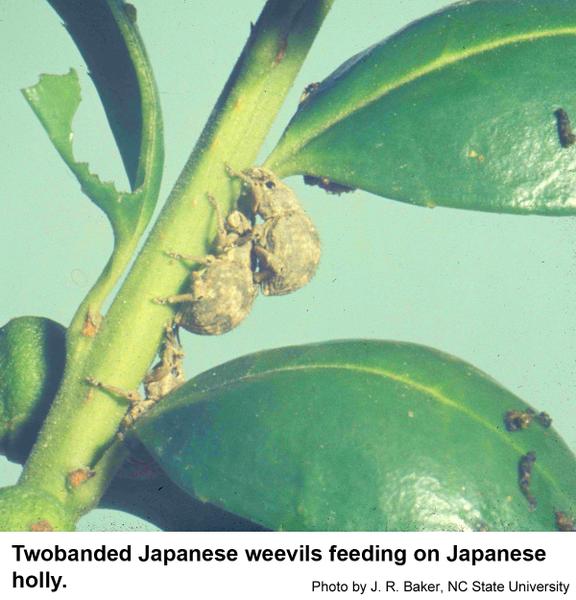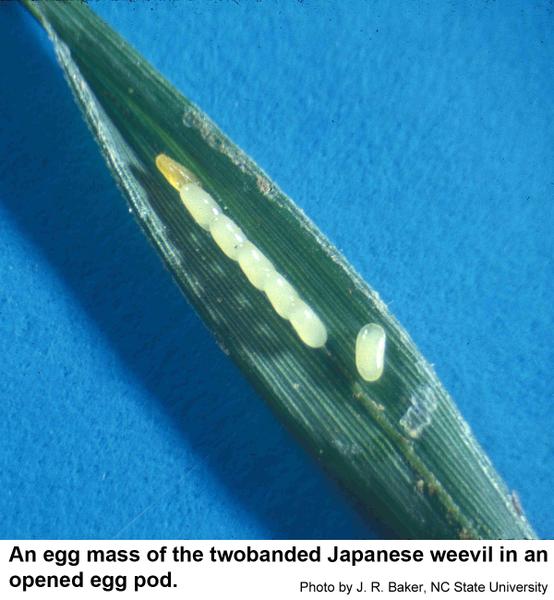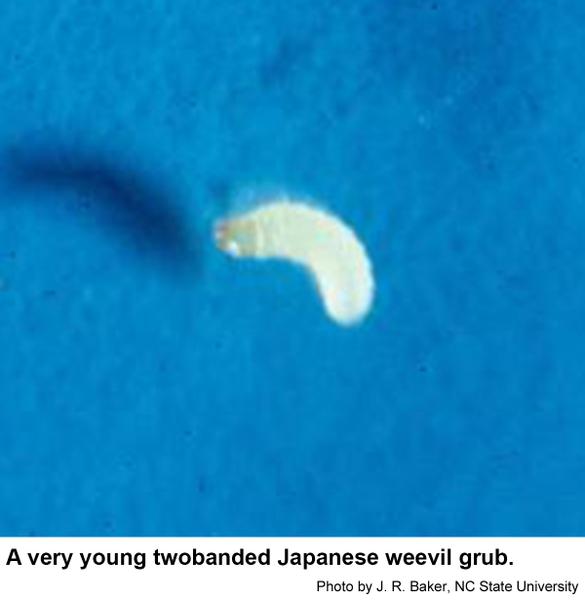General Information
Twobanded Japanese weevils, Pseudocneorhinus bifasciatus, are about 1/4 inch long and are light or dark brown to gray with a short, blunt snout. The wing covers (elytra) have indistinct white stripes in grooves, white spots toward the back, and two dark brown or black transverse bands. Small, elongate and cream colored eggs are usually sealed in a folded blade of grass or other folded leaf. Fully-grown larvae are white, legless, and just over 1/4 inch long. The pupa is white with yellow-brown setae, and is about 1/4 inch long.
Biology
We assume Japanese weevils are parthenogenetic because no males have been recorded in the United States (Males have been collected in China). Eggs are deposited in small batches protected by folds along leaf margins that form a pod around the eggs. Females can lay over 350 eggs each when feeding on rose. As the eggs hatch, the larvae burrow into the ground and feed on the roots. These weevils lack flight wings, have fused wing covers, and are unable to fly. They feed during the day, but if disturbed, twobanded Japanese weevils drop to the ground and remain motionless. In autumn, the weevils hibernate in leaf litter and resume feeding the following spring. One generation occurs each year although there is some overlap of overwintering plus new adults during the growing season.
The twobanded Japanese weevil was first found in the United States in 1914 near Philadelphia. It is now established in the eastern United States. Some of the plants attacked by the twobanded Japanese weevil are ash, azalea, barberry, burr marigold, camellia, dogwood, lilac, mountain laurel, privet, rhododendron, rose, spirea, strawberry, and weigela. Twobanded Japanese weevil larvae feed on plant roots, but the adults do serious and apparent damage. The weevils feed extensively on new leaves, shoots, and inner foliage. As a result, infested plants are tattered and unhealthy in appearance.
Control
Residential Recommendations
Because twobanded Japanese weevils feed during the day but drop from infested shrubs when disturbed, many can be trapped and destroyed. Taking care not to jar the plant, place a plain cloth or large sheet of paper under the shrub and then tap or shake the plant vigorously. Many weevils will fall off and can be destroyed by dropping them into soapy water, by freezing them, or some other method.
If chemical control is opted for, homeowners may find BioNeem or pyrethroids useful. Pyrethroids are very toxic to insects but are not particularly hazardous to humans and pets (other than fish - avoid using pyrethroids around pools, ponds, and streams). Pyrethroids labeled for residential landscape use are readily available in most big box stores, plant centers, and nurseries. Active ingredients of all pesticides are listed on the front label usually in very small font near the bottom. Active ingredients of pyrethroids end with "-thrin." Pyrethroids other than resmethrin and pyrethrum have a long residual life in the environment so one treatment should protect the plant for several weeks. Be sure to follow the directions for safe use found on the label of whatever pesticide is used.
Commercial Recommendations
Twobanded Japanese weevils are apparently resistant to carbaryl (Sevin). Commercial growers and landscapers can use a pyrethroid (Astro, Mavrik, Talstar or Tempo 2) for control.
Tests on the similar black vine weevil show pesticides may be applied to the media or soil surface as a drench to control black vine weevil larvae. Imidacloprid (Merit, Marathon) can be used as a soil injection or drench against larvae. Scimitar & Demand (Oregon study) and Talstar (Ohio study) are effective when adults are present. Aloft may also be an effective product.
Acephate also is effective for twobanded Japanese weevil management. The following table gives amount needed per gallon for various acephate formulations.
| Pesticide (Trade Name) | Formulation | Amount |
|---|---|---|
| acephate (Orthene) | 75% soluble powder | 1 tablespoon per gallon for tree and ornamental. 1 pound per 100 gallons of water. (Not labeled for twobanded Japanese weevil but labeled for black vine weevil, strawberry root weevil, root weevil, and numerous other pests on many ornamental plants.) |
| acephate (Orthene) | 9.4% emulsifiable concentrate | 3 tablespoons per gallon of water. (Not labeled for the twobanded Japanese weevil but labeled for black vine weevil, obscure root weevil, and numerous other pests on many ornamental plants.) |
| azadirachtin (Azatin EC, BioNeem) | 3% emulsifiable concentrate | Azatin EC is federally labeled for twobanded Japanese weevil but the pests and rates of application are not listed. |
Other Resources
- Common name: twobanded Japanese weevil, scientific name: Pseudocneorhinus bifasciatus Roelofs (Insecta: Coleoptera: Curculionidae). Gyeltshen, J. and A. Hodges. 2009 (revised). Featured Creatures, Entomology & Nematology, FDACS/DPI, EDIS, Pub. No. EENY-361.
- Japanese Weevil. Theresa A. Dellinger, T. A. 2020 (revised). Virginia Coop. Extension, Entomology, Pub. 444-624 (ENTO-362NP).
- Twobanded Japanese Weevil – Another Invasive Pest. Jesse, L. 2016. Horticulture and Home Pest News, Iowa State University Extension and Outreach.
- NC State Extension Plant Pathology Publications
- NC State Horticultural Science Publications
- Insect and Related Pests of Shrubs
- North Carolina Agricultural Chemicals Manual
For assistance with a specific problem, contact your local Cooperative Extension center.
Publication date: Aug. 1, 1994
Reviewed/Revised: Oct. 17, 2019
Recommendations for the use of agricultural chemicals are included in this publication as a convenience to the reader. The use of brand names and any mention or listing of commercial products or services in this publication does not imply endorsement by NC State University or N.C. A&T State University nor discrimination against similar products or services not mentioned. Individuals who use agricultural chemicals are responsible for ensuring that the intended use complies with current regulations and conforms to the product label. Be sure to obtain current information about usage regulations and examine a current product label before applying any chemical. For assistance, contact your local N.C. Cooperative Extension county center.
N.C. Cooperative Extension prohibits discrimination and harassment regardless of age, color, disability, family and marital status, gender identity, national origin, political beliefs, race, religion, sex (including pregnancy), sexual orientation and veteran status.




